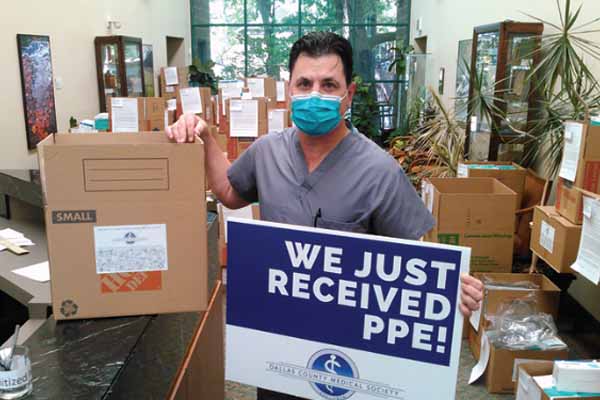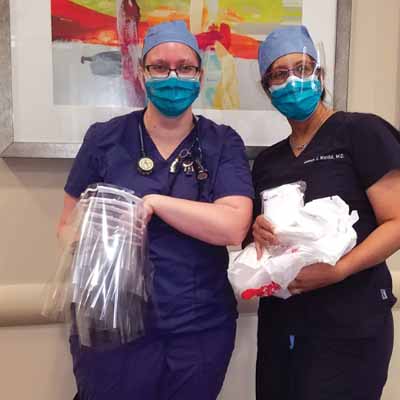
Before 2020, physicians in the county medical societies in the Dallas-Fort Worth region had little official contact, says Aimee Garza, MD, a Frisco neurologist and neurophysiologist. They never worked together or coordinated efforts.
“I haven’t really had any interaction with other medical societies other than at TexMed,” said Dr. Garza, referring to the Texas Medical Association’s annual meeting of the state’s physicians.
Then came COVID-19.
Suddenly, North Texas physicians – like every professional in health care – needed personal protective equipment (PPE) to guard against the new and deadly disease, and there was none to be had because of supply shortages, says Easwar Sundaram, MD, a McKinney neurologist.
“There was a time when nothing was available, not even on Amazon,” he said. “The hospitals were able to get [PPE], but the independent physicians could not.”
So, five North Texas medical societies representing about 11,500 physicians from six counties – Collin, Dallas, Denton, Fannin, Grayson, and Tarrant – started working together with TMA to secure PPE. (See “Paying the Price for PPE,” June 2020 Texas Medicine, pages 22-26, www.texmed.org/PriceForPPE).
Those counties formed the North Texas Medical Society Coalition and found that by coordinating their efforts – along with TMA’s statewide efforts – they could more easily track down and distribute PPE than if they were working alone, says Dr. Sundaram, who represents the Grayson County Medical Society on the coalition board (www.northtexasmsc.org).
“The coalition’s [work] through TMA was just incredible,” he said. “When the counties got together, we were able to petition [PPE merchants] to get more supplies. Together we stand.”
What started as a partnership of convenience among the county medical societies turned out to be a beautiful friendship, Dr. Sundaram says. It evolved with the pandemic to help physicians in those counties address misinformation about the disease and help them obtain vaccines when they were in short supply.
Other county medical societies have pooled their resources in a regional effort, says Denton internist John Flores, MD, the coalition chair. For instance, TMA’s Border Health Caucus has long focused on health issues along the Texas-Mexico border.
But this is the first time county medical societies have banded together so quickly to address a natural disaster, he says.
“I think it would be a good model for other regions to follow in case of a crisis,” he said.
Working together so closely made the county medical societies even more effective in addressing physicians’ needs, says Dr. Sundaram.
“I’ve been in organized medicine for 33 years, and the county medical society … is there for the physicians, but it has done more in the last year and a half than in the previous years combined,” he said.
Debunking COVID-19 myths
The coalition made sense, in part, because the six counties represented include the bulk of North Texas’ population and those areas are deeply interconnected, says internist and Dallas County Medical Society (DCMS) President Beth Kassanoff-Piper, MD, the coalition vice chair.
“[Our patients] may live in one [county] and work in another, and what affects one of our counties affects us all,” she said. “When hospitals get full in Grayson County, those overflow patients are going to need to go to, say, Collin County.”
Once the North Texas physicians began working together to obtain PPE, they realized COVID-19 left them with other problems, Dr. Flores says.
“The PPE was how we got together. But once we got together, we realized we had shared goals and needs, and we decided to get together and talk about what those are,” he said.
The PPE crisis went hand in hand with a crisis of information – or misinformation – about COVID-19, Dr. Kassanoff-Piper says.
“There was so much misinformation out there,” she said. “We wanted to share with the public – our patients – what was real, what was scientifically based, what they should rely on, and who they could trust to get their information.”
The coalition helped produce Facebook Live segments that addressed topics like the need for masking and handwashing and the differences among the COVID-19 vaccines (www.facebook.com/NorthtexasMSC/). Coalition members also spoke regularly on local TV stations.
“We had a Facebook Live [event] on how exactly the COVID virus works,” Dr. Flores said. “We had a physician-historian from San Antonio talk about the history of vaccines, and he talked about the polio vaccine rollout, how people stood in line and were so happy to get it.”
Sticking to science was not always popular with listeners, Dr. Flores says. For instance, a few people accused the North Texas physicians of being “shills” for vaccine companies.
“You do what you can in the face of that kind of negativity, and hopefully it wasn’t from malice but from fear and a lack of information,” Dr. Flores says. “We felt that coming from us, physicians who work in our communities, it was a stronger message, rather than having somebody who works in Washington or maybe even from Austin.”
Physicians directly shaped the coalition’s message and spearheaded the effort to get it out, Dr. Flores says. But the communications initiative and the effort to obtain PPE also paid off because of the hard work of staff members from the five county medical societies.
“They were doing this outside of their normal jobs as county medical executives, and it was unfunded and unpaid,” Dr. Flores says. “We had leadership meetings weekly and county medical society meetings for a while there every Monday. So, it was a lot of extra work on their part.”

Vaccines arrive
When COVID-19 vaccines became available in December 2020, physicians were among the first groups designated to get immunized. But as with PPE, shortages made obtaining the vaccinations difficult for independent physicians, Dr. Kassanoff-Piper says.
“Our physicians who were in [medical] groups owned by hospitals were able to get their shots there, but individual practitioners or smaller groups really didn’t have anywhere to go,” she said.
There were also storage problems, says Jon Roth, DCMS executive vice president and CEO. For instance, Pfizer’s COVID-19 vaccine – the first one available – required ultra-cold freezer storage and came in 975-dose lot sizes.
Also, Texas – like most other states – doesn’t have the public health infrastructure to ramp up a mass-vaccination program quickly, he said.
So, DCMS set up its own infrastructure by working with the local pharmacies that had also received vaccine doses. Together, they began to vaccinate physicians and their staff members in all six counties, Mr. Roth said. The coalition vaccination program allowed physicians to easily arrange an appointment in a designated pharmacy or attend one of several mass vaccinations events, including several at the Collin, Dallas, and Tarrant county medical society offices. More than 20,000 vaccines were administered to physicians and their staff in the first two weeks of January.
“It was unbelievable how they were able to vaccinate a lot of these doctors and get them back to work safely, seeing patients again,” Dr. Kassanoff-Piper said.
Once most area physicians received their shots, the coalition pivoted to helping physician offices obtain vaccine doses for patients, Mr. Roth says.
First, the coalition worked with TMA to encourage the Texas Department of State Health Services to reduce the amount of paperwork physicians had to do to enroll as vaccine providers, he says.
Early on, state health officials believed large hubs were the most efficient way to distribute COVID-19 vaccines. The coalition and TMA worked to convince state health officials that physician practices could reach far more people, Mr. Roth says.
“Once they understood that policy position of how the number [of vaccinations could increase] once they got vaccines into the small offices, we started to see the easing of restrictions and the actual vaccines flow into those offices,” Mr. Roth said.
Now that enough vaccine doses are available for everyone, the coalition has focused on encouraging people to take them, says Dr. Garza, who represents the Collin-Fannin County Medical Society on the coalition board. But that’s difficult because misinformation about the vaccines remains so widespread.
With older patients mostly immunized, the biggest target audience today is 20- to 40-year-olds, especially women, Dr. Garza says. Many of them remain concerned about false reports that the COVID-19 vaccines cause infertility (See “Talk to Patients About: Messenger
RNA Vaccines, July 2021 Texas Medicine, page 48, www.texmed.org/RNAvaccines.)
“It’s a question I hear quite often,” she said. “Today, I was doing a lunch program and one of the [people] I was talking to came out and said, ‘Is this true? What do you know about it?’ That particular rumor started on the internet, and it’s very hard to debunk.”
The coalition will continue with COVID-19 education as long as it’s needed and may work together on other projects, like education about flu vaccines or other public health priorities, says Dr. Kassanoff-Piper.
“We see the benefits for every one of us,” she said. “It’s very powerful.”